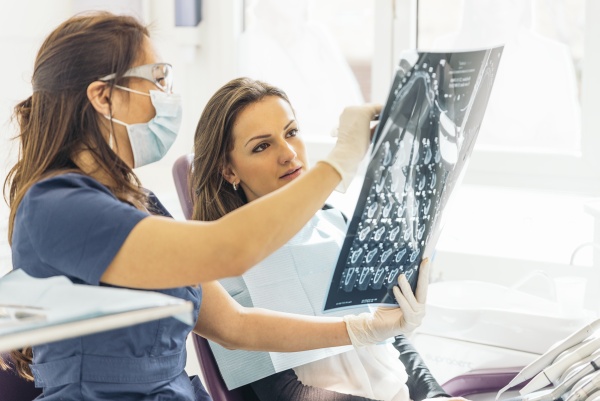All About Dental X-Rays: Are They Safe?

It is nothing to worry about
Dental X-rays are an important part of the diagnosis and treatment of oral health problems. When you start seeing a new dentist, they will ask you for recent X-rays and dental records. If you do not have any, the dentist will take X-ray images of your teeth and jaws.
What tends to worry people the most about X-rays is the radiation. While X-ray machines do work by directing radioactive rays at the teeth and jaw, the radiation from these machines is less than what we are exposed to in our everyday lives.
Why do dentists need X-ray images?
Dental images help a dentist diagnose dental problems and come up with treatment plans. The images also help the dentist monitor the progress of a particular treatment. The many uses of dental X-rays include:
- To evaluate the health of a patient's teeth, gums and jaw and check for cavities and injuries
- To see the extent of teeth and jaw misalignment
- To determine if a patient is a good candidate for dental implants
- To monitor the progress of dental treatments like implants and bone grafts
How do X-ray machines work?
X-rays are a type of radiation that is generated when a fast-moving stream of electrons smash into a positively charged surface. The whole process of generating X-rays happens in an X-ray tube, which is made up of three parts:
1. The filament is found at one end of the X-ray tube. When electricity passes through the filament, it heats up and emits electrons.
2. The target surface or anode is found at the other end of the tube, opposite the filament. It has a positive charge that attracts the emitted electrons, which are negatively charged. Traditionally, the surface was made of tungsten.
When the electrons are generated by the filament, they are attracted by the anode. The force of attraction pulls them toward the anode at high speed, and they collide into the anode's surface. The collision causes the release of radiation.
3. The position indicating device (PID) is part of the housing that encases the X-ray tube. Its job is to guide the generated X-rays through the teeth and jaws to the X-ray film. Health regulations require that the PID should release an X-ray beam no wider than seven centimeters.
How does the dentist take an X-ray of the mouth?
Most dental X-rays are intra-oral, which means that the x-ray film is placed in the mouth. The dentist asks the patient to bite down on a thin, cardboard-covered X-ray film. The dentist and patient will wear lead aprons to block radiation from reaching the body. The dentist will then use the X-ray machine to take detailed images of the teeth, jaw and soft tissue.
What happens to the X-ray beam emitted by the machine?
1. Most of it is absorbed by tissues in the part of the mouth that the dentist wants to image.
2. The beam passes through the tissues and hits the X-ray film. Where X-rays come into contact with the film, that particular spot on the film turns black. The bones and teeth do not allow X-rays to pass through them. The part of the film directly behind the teeth and jaws remains light-colored.
3. The rest of the beam is scattered by the other tissues in the mouth.
The amount of radiation absorbed by a person during a dental x-ray is much less than the amount absorbed from sunlight or a microwave oven.
When should dental X-rays be avoided?
- Pregnant women should avoid X-rays if they can, but not if the X-ray is essential to their health
- A leaded thyroid collar is recommended to protect the thyroid in women of childbearing age
Do not be afraid of an X-ray
Medical professionals only use X-ray imaging when they have to. And even then, the amount of radiation needed to take an X-ray is minuscule. So, when the dentist asks to take a dental x-ray, it is only because it is needed for the treatment of your teeth.
Need dental care?
Call (305) 203-4132 today to reach Gables Exceptional Dentistry.
Related Posts
Curious about laser dentistry? Read on to learn more about this type of treatment. Medical professionals may modify or remove tiny quantities of tissue using lasers. While laser surgery has numerous applications outside of dentistry, the vast majority of patients had never ever heard of laser dentistry until they needed it. Dentists employ lasers for…
Correcting mouth issues with a beam of light might sound like science-fiction, but laser dentistry is a present, common, and effective practice. Dental lasers are less noisy and less invasive than traditional drills. They often cause less anxiety and fear during dental procedures and reduce healing times and pain as well. With all this in…
For individuals with a variety of oral health issues, laser dentistry can offer efficient treatment options with a host of benefits. However, some dental patients may be wary of such procedures due to lack of information or experience. Understanding the process and the number of problems it can address can help patients choose the appropriate…
Laser dentistry is a great option for painless dental treatment that does not need the use of metal tools.Instead of having to use traditional metal tools to clean your teeth, we can use laser dentistry. Along with enhancing the overall cleaning process, laser dentistry can also help with various procedures in the dental office. With…
